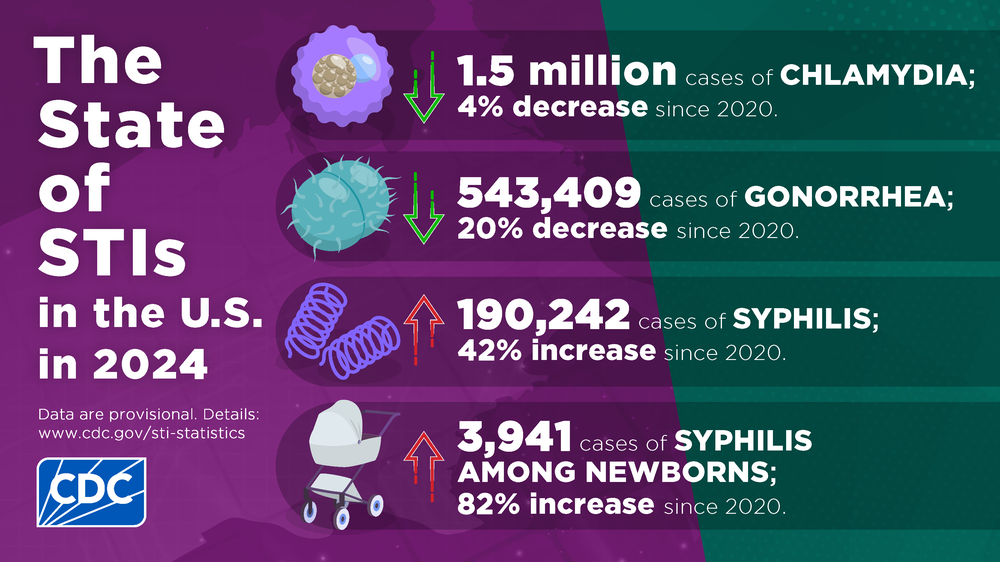
Data & Statistics
Sexually Transmitted Diseases (STDs) continue to rise in the United States, and trends throughout the southeastern states resemble those of the nation. One in two sexually active persons will contract an STD by age 25 (Cates et al., 2004). The Centers for Disease Control and Prevention (CDC) estimates that nearly 20 million new STIs occur annually in this country, half of those among young people aged 15–24 (CDC, 2015). Click the link below for more information about the latest CDC 2024 Surveillance Report. The data presented here provides additional details about STDs in Georgia.
State of STDs in Georgia: Preventing Sexually Transmitted Diseases (2023)
*NEW*: CDC 2024 STD Surveillance Report (Provisional)

The CDC has published its provisional 2024 Sexually Transmitted Infection (STI) Surveillance Report, highlighting national trends and reinforcing the need to continue prioritizing STI prevention and treatment.
In 2024, more than 2.2 million STIs were reported across the United States. This marks a 9% decline in the combined number of chlamydia, gonorrhea, and syphilis cases compared to 2023—our third consecutive year of decline. While this progress is encouraging, it is important to note that compared to a decade ago, overall cases remain 13% higher, and congenital syphilis has increased nearly 700%. These numbers show that although gains are being made, the overall burden of STIs is still unacceptably high and continues to demand national attention.
Click here to access the full CDC Sexually Transmitted Disease Surveillance Report.
Georgia’s 2024 Data Snapshot
The following summarizes Georgia’s 2024 case counts compared to the previous year:
- Chlamydia cases reported to the CDC decreased from 71,294 cases in 2023 to 66,884 cases in 2024. This is a 6% decrease in cases since 2023.
- Gonorrhea cases decreased from 30,306 in 2023 to 27,649 in 2024. This is a 9% decrease in cases since 2023.
- Primary & secondary (P&S) syphilis decreased from 2,210 cases in 2023 to 1,842 cases in 2024. This is a 17% decrease in cases since 2023.
- Congenital syphilis cases decreased from 127 in 2023 to 126 cases in 2024. This is a 1% decrease in cases since 2023.
Key takeaway for Georgia
While reported infections have declined, congenital syphilis remains a critical public health issue due to its severe effects on newborns.
Looking for More Georgia STD Data? Online Analytical Statistical Information System (OASIS)
Obtain tables, maps, and charts of various public health indicators. Vital statistics (births, deaths, fetal deaths, induced terminations), hospital discharge, emergency room visits, STDs, motor vehicle crashes, and population data are included. All data can be selected by age, race, sex (Person), state, county, census tract/ county commission district/ Demographic Cluster available (Place), and year (Time).
Click here for more OASIS Data & Statistics
Additional Data Resources:
The CDC has released the 2023 STD and Congenital Syphilis (CS) data, now accessible via AtlasPlus, a powerful tool offering nearly 20 years of surveillance data. Users can explore STD trends, generate customized visualizations, and analyze data alongside social determinants of health (SDOH) to uncover disparities and inform targeted interventions.
Learn more and access the data at the CDC AtlasPlus Tool
Looking for Additional CDC Data? CDC Data & Statistics
Page Last Updated 09/29/2025